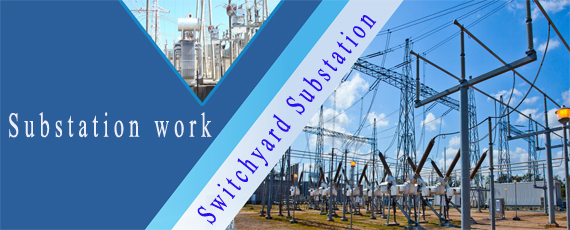Electrical Substation Work
Substation Work
Indoor substations are electrical substations where all the equipment is housed within a building. They are typically used in areas where space is limited or where the surrounding environment is contaminated with impurities like metal corroding gases and conductive dust1. These substations are generally designed for voltage levels up to 11 kV, but can be used for higher voltages up to 66 kV in special cases.
The main components include:
- ● Control Compartment: Houses control equipment and protective devices.
- ● Bus-Bar Compartment: Contains the main bus-bars for power distribution.
- ● Current Transformer and Cable Sealing Box Compartment: Houses current transformers and cable sealing boxes.
- ● Fire-Fighting Equipment: Includes storage batteries, fire extinguishers, and emergency lighting.
Outdoor Substations
Outdoor substations are electrical substations where the equipment is installed in an open-air environment. They are commonly used for voltage levels ranging from 55 kV to 765 kV3. These substations require more space but are quicker to construct.
The main types include:
- ● Pole-Mounted Substations: Used for supporting distribution transformers up to 250 kVA. Equipment is mounted on high tension distribution line structures3.
- ● Foundation-Mounted Substations: All equipment is assembled and embedded within a fenced area for safety. Suitable for higher capacity transformers3.
Key Differences
- ● Location: Indoor substations are inside buildings, while outdoor substations are in open-air environments.
- ● Voltage Levels: Indoor substations typically handle up to 66 kV, whereas outdoor substations can handle up to 765 kV2.
- ● Construction Time: Outdoor substations are quicker to construct but require more space.
- ● Environmental Suitability: Indoor substations are used in contaminated environments, while outdoor substations are used in open areas.
Building Services
Building services are essential systems and components that ensure the functionality, comfort, safety, and efficiency of buildings.
Here is an overview of some key building services:
- 1. Electrical Systems
- ● Lighting: Ensures proper illumination for safety, functionality, and aesthetics.
- ● Power Distribution: Delivers electrical power to various parts of the building.
- ● Backup Systems: Includes generators and UPS systems for power continuity.
- 2. Fire Protection Systems
- ● Fire Alarm Systems: Detects and alerts occupants to fire emergencies.
- ● Fire Suppression Systems: Includes sprinklers, fire extinguishers, and hydrants.
- ● Emergency Exits: Provides safe evacuation routes in case of fire.
- 3. Security and Access Control
- ● Surveillance Systems: Monitors activities and ensures safety within the building.
- ● Access Control: Regulates entry and exit points to enhance security.
- 4. Communication Systems
- ● Intercoms: Facilitates internal communication within the building.
- ● Public Address Systems: Delivers important announcements and alerts.
Importance of Building Services
Building services play a crucial role in ensuring the smooth operation of modern buildings. They enhance occupant comfort, safety, and productivity while also contributing to energy efficiency and sustainability. Proper design, installation, and maintenance of these services are vital for the overall performance and longevity of the building.
